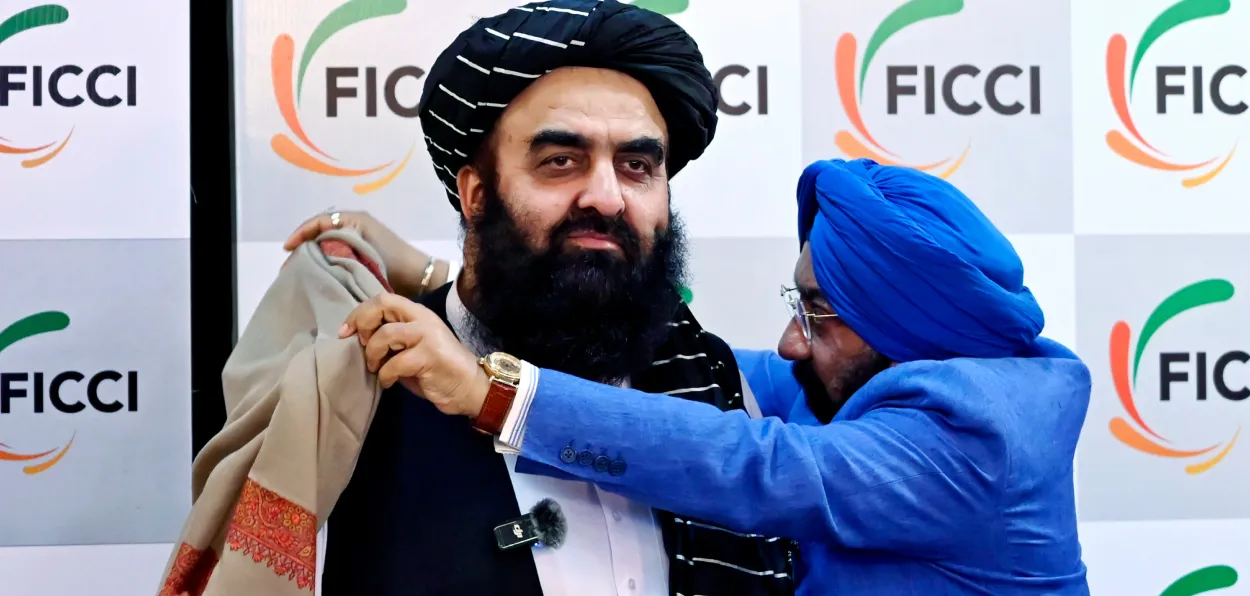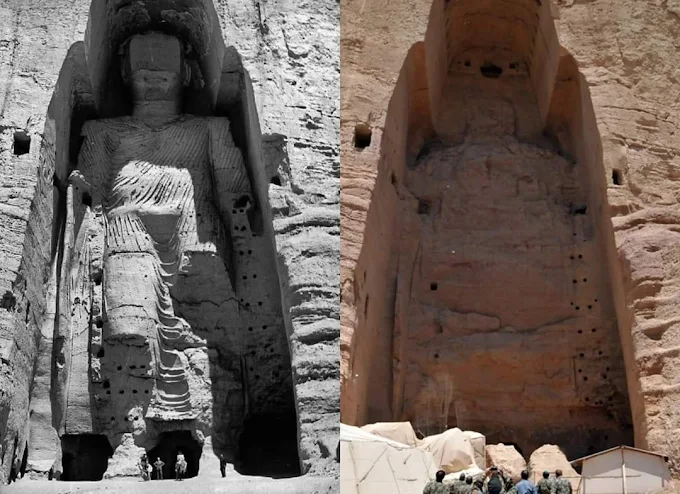
Ghulam Rasool Dehlvi
More than two decades ago, the Taliban’s destruction of the ancient Bamiyan Buddhas—towering 6th-century marvels carved into Afghanistan’s sandstone cliffs. The world remembers that moment in 2001 not merely as an iconoclastic act, but as a wound against human civilisation. Today, however, the Taliban face a historic opportunity: to rebuild what was once destroyed—not only in stone, but in spirit.
The cliffs of Bamiyan, once adorned by two colossal Buddhas, are still silent. The niches where they stood—55 and 38 meters high—gape like hollow eyes over the valley, testaments to a cultural loss that reverberates far beyond Afghanistan.
In March 2001, the Taliban reduced these ancient marvels to rubble, claiming religious justification. Yet more than two decades later, the question remains: can the Taliban, which is now the Afghan authority, restore what was destroyed? More importantly, should they even consider it? The answer, from both established Islamic ethics and historical precedent, is a resounding yes.
The Bamiyan Buddhas were not mere stone statues. Carved in the 5th and 6th centuries, they represented the Gandhara artistic tradition, a synthesis of Hellenistic, Persian, and Indian styles, standing as witnesses to over 1,400 years of Buddhist presence in Central Asia. They were also symbols of human intellect and spiritual aspiration, a reflection of Gautama Buddha’s wisdom—the essence of “Buddh,” or reason. Sufi masters like Hazrat Inayat Khan described such wisdom as “Buddhi, the inner light that allows one to see life clearly,” a guiding principle resonant with the Sufi pursuit of divine knowledge.
The Taliban, in destroying these monuments, claimed they were enforcing the fundamental Islamic tenet of Tawheed—the oneness of God—by eliminating idols. Yet classical Islamic jurisprudence makes a critical distinction: idols actively worshipped are forbidden, but ancient relics of bygone civilisations, no longer the focus of devotion, are not objects of concern. The Qur’an instructs:
“Do not insult those they call upon besides Allah, lest in hostility they insult Allah without knowledge” (al-An‘ām 6:108).
Prophetic precedent reinforces this ethic. The Prophet Muhammad, encountering Christian and Jewish sacred objects, did not order their destruction. Caliph Umar ibn al-Khattab, upon entering Jerusalem, chose not to pray inside the Church of the Holy Sepulchre, recognising its sanctity and preserving it as a symbol of faith, not a conquest. The Taliban’s act, therefore, was a distortion of Islam—an ideological choice rather than a divine command.

Bamiyan Buddhas
History bears witness. For centuries, Afghan rulers and Muslim dynasties preserved the Bamiyan Buddhas. The Ghaznavis, despite iconoclastic raids in India, left the statues untouched. The Timurids, Safavids, and Mughals incorporated Bamiyan into their cultural consciousness. Even Afghan monarchs of the 19th century used the valley as a source of national pride. It was the Taliban alone, earlier shaped by refugee-camp madrassas and radicalised interpretations of Islam, who saw the Buddhas as 'enemies of monotheism'.
The destruction, moreover, was deeply political. UNESCO, Buddhist-majority nations like Japan, and global cultural organisations pleaded for preservation. However, Mullah Omar rejected these appeals, framing the act as defiance against foreign influence and as proof of ideological purity to hardline clerics. In other words, the Buddhas were destroyed not out of piety, but to assert power.
Yet the spiritual, ethical, and cultural imperative for Afghanistan—and for the Taliban themselves—remains: to rebuild, restore, and reconcile. Rebuilding the Bamiyan Buddhas need not contradict Islam. On the contrary, Islam emphasises mercy (rahmah), wisdom (hikmah), and justice (‘adl). To restore the monuments would be a profound act of tawba, acknowledging past misdeeds while reaffirming stewardship over creation, both human and divine.
The Taliban can rebuild the statues in cooperation with international agencies like UNESCO, Japan (which funded early restoration), Iran, and Muslim-majority countries with proven conservation expertise like Turkey and Indonesia!
They could celebrate the Buddhas not as idols—but as symbols of Afghan history, craftsmanship, and resilience!
The act transforms the Taliban from destroyers into guardians of the human legacy. Islamic history prizes preservation of knowledge and monuments. From the pyramids in Egypt to Buddhist relics in Central Asia, Muslim rulers historically protected the heritage of earlier civilisations, recognising it as part of the divine tapestry of human endeavour.
Critics in Afghanistan or elsewhere in the Muslim world may argue that rebuilding risks condoning idol worship or betraying fundamental Islamic principles. Yet classical Islamic jurists and even Hanafi-Deobandi scholars like Maulana Ashraf Ali Thanvi or Hussain Ahmad Madani, greatly revered by Afghan Taliban, never sanctioned the destruction of dormant archaeological symbols. The Taliban’s hybrid ideology, blending Deobandi structures with Wahhabi literalism, was a modern aberration, not a reflection of traditional Islamic jurisprudence. Islam’s true legacy of cultural heritage preservation, as Prophet Muhammad exemplified, lies in the Quranic exhortation. That is, "And whoever honours the symbols of God - indeed, it is from the piety of hearts (22:32). It requires from the authorities like the current ruling dispensation in Afghanistan, maintaining integrity, mercy, stewardship, and respect for the historic symbols of other faith traditions, including the works of human hands that seek beauty and divinity.
The Bamiyan Buddhas, though destroyed in stone, continue to exist in spiritual consciousness. They remind us of the fragility of human civilisation and the responsibility of those in power to protect it.
In rebuilding the Bamiyan Buddhas, the Taliban have a chance to reverse history and heal the wounds of the past. They could transform Afghanistan into a beacon of reconciliation, culture, and moral reflection. Afghanistan’s cliffs could once again reflect that light, reminding all who see them of human creativity, courage, and the capacity for redemption.
Sufi heritage in Herat, in western Afghanistan, is also a significant reminder of Afghanistan's deeply seated Islamic and Sufi traditions of protecting spiritual, architectural, and cultural history. During the Timurid dynasty (14th–15th centuries), Herat was closely associated with the Naqshbandi, Chishti, and Kubrawi orders, each leaving an indelible mark on Indo-Afghan spiritual ties. Prominent Sufi saints of India and Kashmir, including Khwaja Moinuddin Hasan Chishti of Ajmer Sharif and Shah e Hamadan Mir Sayyid Ali Hamadani and other Chishti-influenced Sufis greatly contributed to Herat’s spiritual legacy, emphasising artistic achievement, aesthetics, and devotional practices as paths to divine proximity.
Herat is still home to Sufi shrines featuring Timurid-style architecture, such as the dargah of Khwaja Abdullah Ansari, also known as "Hujjat al-Islam of Herat". An enduring site of pilgrimage, spiritual learning, calligraphy, manuscript illumination, and miniature painting, Sufi heritage in Herat contributed to a fusion of spirituality and artistic expression, creating a unique cultural landscape in Central Asia.
It can also transform Bamiyan into a cultural tourism hub, at a time when Afghanistan desperately needs economic revival. Heritage tourism is one of the world’s fastest-growing sectors. A restored Bamiyan—with eco-tourism, museums, cultural trails, and Sufi-Buddhist dialogue centres—could turn the valley into Afghanistan’s Petra or Cappadocia.
ALSO READ: Aijaz Dhebar: Mayor, who transformed Raipur into India's 12th cleanest city
Rebuilding the Bamiyan Buddhas is about reviving Afghanistan’s soul. These statues stood for 1,500 years as witnesses to empires, caravans, monks, mystics, and travellers. Their destruction was a tragedy. Their reconstruction can become a triumph. Therefore, Taliban now faces a defining question: Will they be remembered as the destroyers of history—or the unlikely guardians who helped rebuild it?
The world is watching. The tools exist. The support awaits. All that is required is a single announcement— Let the Buddhas of Bamiyan rise again.
Ghulam Rasool Dehlvi is the author of “ISHQ SUFIYANA: Untold Stories of Divine Love”
